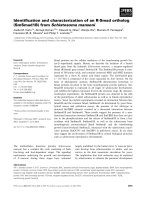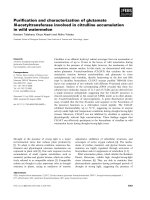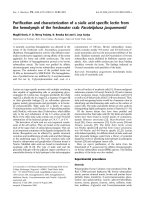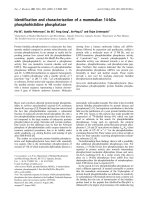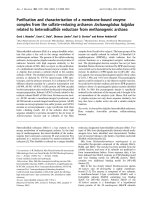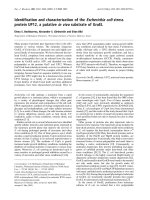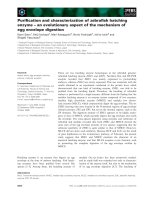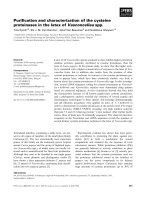Báo cáo Y học: Purification and characterization of three galactose specific lectins from Mulberry seeds (Morus sp.) ppt
Bạn đang xem bản rút gọn của tài liệu. Xem và tải ngay bản đầy đủ của tài liệu tại đây (452.03 KB, 6 trang )
Purification and characterization of three galactose specific lectins
from Mulberry seeds (
Morus
sp.)
Tanzima Yeasmin, Md Abul Kashem Tang, Abdur Razzaque and Nurul Absar
Department of Biochemistry, University of Rajshahi, Rajshahi-6205. Bangladesh
Three lectins were extracted and purified from mulberry
seeds by gel filtration of 100% ammonium sulfate saturated
crude protein extract followed by ion-exchange chromato-
graphy on DEAE and CM-cellulose. The lectins were found
to be homogeneous as judged by polyacrylamide disc gel
electrophoresis. The molecular masses of the lectins as
determined by gel filtration were 175 000 for MSL-1,
120 000 for MSL-2 and 89 500 for MSL-3. MSL-1 is dimer
in nature, with the two monomers held together by disulfide
bond(s), while MSL-2 and MSL-3 contain four nonidentical
subunits that are held together by nonionic hydrophobic
interactions.
The lectins agglutinated rat red blood cells and this
agglutination was inhibited specifically by galactose,
methyl-a-
D-galactopyranoside, methyl-b-D-galactopyrano-
side, lactose and raffinose. The lectins MSL-1, MSL-2 and
MSL-3 contained 5.7, 5.4 and 4.5% neutral sugars, respec-
tively, and the sugar composition of the lectins was glucose
and mannose for MSL-1 and galactose for both MSL-2 and
MSL-3. The lectins exhibited strong cytotoxic effect in brine
shrimp lethality bioassay.
Keywords: mulberry seeds; galactose-specific lectins;
subunit structure; hemagglutination; cytotoxicity.
Mulberry (Morus alba L.) is the sole host plant of the
silkworm Bombyx mori Linn, which produces silk. It
belongs to the family Moraceae, part of the genus Morus. It
is a deep rooted perennial plant, widely distributed in Asia,
Europe, Africa and Latin America in a wide range of
climatic conditions varying from temperate to tropical. The
silkworm can only obtain nutrients necessary for growth
from mulberry leaves.
Lectin, isolated chiefly from plants, bacteria, fungi,
invertebrates and vertebrates, are nonimmunoglobulin-type
carbohydrate recognition molecules that are involved in
hemagglutination, lymphocyte transformation, inactivation
of certain types of tumor cells and precipitation of certain
polysaccharides and glycoproteins [1,2]. Plant lectins
isolated from a wide variety of plants have recently attracted
great interest because of their remarkable biological
activities. More recently, the lectins as the carbohydrate
binding proteins have been investigated and utilized in
various biochemical fields. Some authors have described the
purification and chemical properties of lectins from many
kinds of plant seeds, such as Phaseolus vulgaris seeds [3],
Viscum album L [4], Lathyrus sativus seeds and [5] Vicia
unijuga leaves [6]. Lectins are being used increasingly to
probe the structure of carbohydrates on the surfaces of
normal and malignant cells [7].
Mulberry plants are propagated either through seeds or
vegetatively. Mulberry seed is oval in shape with a nearly
flat surface. The seed contains about 38% carbohydrate,
32% fat and 15% protein [8]. This paper describes the
purification and characterization of three galactose-specific
lectins from the seeds of mulberry.
MATERIALS AND METHODS
Mulberry seeds were collected from the experimental plot of
Bangladesh Sericulture Research and Training Institute,
Rajshahi. Sephadex G-150, Sephadex G-75, DEAE-
cellulose, CM-cellulose and Sepharose 4B were purchased
from Sigma Chemical Co. All the other reagents used were
of analytical grade. Unless otherwise specified, all
operations were performed at 4 8C.
Preparation of fat free dry powder
The seeds were crushed into paste using a mortar and pestle.
This was then mixed uniformly with precooled petroleum
ether in a homogenizer at 4 8C. The homogenate was filtered
through a clean muslin cloth. The process was repeated at
least twice in order to obtain lipid-free homogenate. Finally,
the filtrate was clarified further by centrifugation at 8000 g,
4 8C for 10 min The precipitate obtained was collected and
air-dried at room temperature.
Preparation of crude protein extract
The protein from fat free dry powder was extracted with five
different solvents (1% CH
3
COOH; 10 mM Tris/HCl buffer,
pH 8.4; 10 m
M phosphate buffer, pH 7.2; 20 mM acetate
buffer, pH 5.0 and distilled water). Water was used for
preparation of crude protein extract from fat free dry powder
as the highest ratio of absorbance at 280 nm and 260 nm
was found in distilled water [9]. The fat free dry powder was
mixed uniformly with precooled distilled water (4 mL
:
g
21
meal) and kept overnight at 4 8C with occasional shaking.
The suspension was then centrifuged at 8000 g,48C for
15 min The clear supernatant was collected and adjusted to
Correspondence to T. Yeasmin, Department of Biochemistry,
University of Rajshahi, Rajshahi-6205. Bangladesh.
Fax: 1 880 721 750064, Tel.: 1 880 880 721 750294,
E-mail: or
(Received 8 May 2001, accepted 21 August 2001)
Eur. J. Biochem. 268, 6005–6010 (2001) q FEBS 2001
100% saturation by adding solid ammonium sulfate. The
precipitate was again collected by centrifugation, dissolved
in the minimum volume of water and dialyzed against 5 m
M
phosphate buffer, pH 7.6, for 24 h at 4 8C. After
centrifugation the clear supernatant was used as crude
protein extract.
Purification of lectin
Gel Filtration. Gel filtration of crude protein extract was
performed on Sephadex G-75 using 5 m
M phosphate buffer,
pH 7.6 at 4 8C.
DEAE-cellulose chromatography. The active protein frac-
tion obtained after gel filtration was dialyzed against
distilled water for 12 h and against 10 m
M Tris/HCl buffer
pH 8.4 overnight, and then loaded onto the DEAE-cellulose
column at 4 8C. The protein was eluted from the column by
buffer containing different concentrations of NaCl (0.06,
0.18 and 0.3
M).
CM-cellulose chromatography. The above protein fractions
needed for further purification after DEAE-cellulose
chromatography was dialyzed 12 h against distilled water
and overnight against 5 m
M phosphate buffer, pH 6.5 and
then loaded onto the column. The protein was eluted from
the column stepwisely using the same buffer containing
0.2
M NaCl.
Polyacrylamide disc gel electrophoresis. Polyacrylamide
disc gel electrophoresis was conducted at room temperature,
pH 8.4 on 7.5% gel as described by Ornstein [10] and 1%
amido black was used as staining reagent.
Characterization of lectin
Molecular mass determination: gel filtration. The molecular
masses of the lectins were determined by gel filtration on
Sephadex G-150 (0.75 Â 100 cm) using lysozyme, trypsin
inhibitor, a-amylase, BSA and b-amylase as reference
proteins.
Molecular mass determination: SDS/PAGE. SDS/PAGE was
conducted on a 10% acrylamide gel according to Weber &
Osborn [11] and the marker proteins used were same as
those used for the gel filtration. Dissociation and reduction
of proteins were performed by heating for 5 min at 100 8C
in 0.1% SDS with 0.1% 2-mercaptoethanol and the proteins
were stained with Coomassie Brilliant Blue R-250.
Hemagglutination studies
Hemagglutinating activity was assayed by the serial dilution
technique using 2% albino rat red blood cells as described
by Lin et al. [12]. Protein solution (0.2 mL) in 5 m
M
phosphate buffer saline, pH 7.2, was mixed with 0.2 mL of
2% rat red blood cell and incubated at 37 8C for 1 h. The
degree of hemagglutination was observed under a
microscope.
The agglutinating activity was expressed as titre (the
reciprocal of the greatest dilution at which visible
agglutination could be detected). The specific activity was
expressed as the titre per mg protein. The hemagglutination
inhibition test was performed in the presence of different
saccharides following the same procedure as described
above.
Affinity chromatography
The pure proteins obtained after dialysis against 5 m
M
NaCl/P
i
, pH 7.2, were applied to a Sepharose 4B column
previously equilibrated with the same buffer at 4 8C. The
adsorbed protein was eluted from the column with the buffer
containing 0.2
M galactose.
Protein and carbohydrate analysis
The concentration of protein was measured by the method of
Lowry et al. [13] using BSA as the standard. The presence of
sugar in the protein was detected by periodic acid Schiff’s
method [14] and the total neutral carbohydrate contents of
the proteins were estimated by phenol/sulfuric acid method
of Dubois et al. [15] with
D-glucose as the standard.
For identification of sugars, the lectins were hydrolyzed
with 1
M HCl for 4 h at 100 8C under vacuum. The sugar
component was determined by the one-dimensional TLC
method described by Joseph & Murrell [16] using different
standard sugars. The chromatogram was developed with the
solvent: Isopropanol, acetic acid and water (3 : 1 : 1, v/v/v)
and the spots were identified by spraying with aniline/
phthalate solution.
Toxicity study
Cytotoxicity was studied using the eggs of the brine shrimp
nauplii (Artemia salina L.). Eggs were placed in one side of
a small tank divided by a net containing 3.8% NaCl solution
for hatching. In the other side of the tank, a light source was
placed in order to attract the nauplii. Two days were allowed
for the hatching of all the eggs and sufficient maturation of
the nauplii for the experiment described by Meyer et al.
[17].
From the stock solution of the lectins (0.9 mg
:
mL
21
), 10,
20, 40, 80 and 160 mL were placed in different vials and
NaCl solution was added to each vial make the volume up to
5 mL; the final concentration of the sample in the vials
became 1.8, 3.6, 7.2, 14.4 and 28.8 mg
:
mL
21
, respectively.
One-hundred brine shrimp nauplii were then placed in
each vial. Three experiments were carried out for the same
concentration and a control experiment was performed
containing 100 nauplii in 5 mL of seawater. After 24 h of
incubation, the vials were observed using a magnifying glass
and the number of survivors in each vial were counted and
noted. From this data, the mean percentage of mortality of
the nauplii was calculated for each concentration.
RESULTS
Purification of mulberry seed lectins
The 100% ammonium sulfate saturated crude protein extract
after dialysis against 5 m
M phosphate buffer, pH 7.6, was
applied to a Sephadex G-75 column at 4 8C previously
equilibrated with the same buffer. As shown in Fig. 1, the
proteins were eluted as one main broad peak, i.e. fraction
F-1 and another small peak, i.e. fraction F-2. The active
6006 T. Yeasmin et al. (Eur. J. Biochem. 268) q FEBS 2001
fraction, F-1, as indicated by the solid line was pooled,
precipitated with 100% saturation by ammonium sulfate,
and purified further by ion-exchange chromatography. The
fraction F-2 was not used for further study as it contained
mainly colored materials and small amounts of low
molecular mass proteins.
The precipitate was dissolved in a minimum volume of
distilled water and dialyzed against 10 m
M Tris/HCl buffer
pH 8.4 at 4 8C for 24 h. After removal of the insoluble
material, the clear supernatant was applied to a DEAE-
cellulose column at 4 8C, previously equilibrated with the
same buffer, and the protein was eluted by a linear gradient
of NaCl from 0.0 to 0.3
M in the buffer. The components of
F-1 were eluted as a single, but broad, peak indicating the
presence of more than one component (data not shown). In
order to separate the components, the elution was carried out
in a stepwise fashion with an increasing concentration of
NaCl in the same buffer. Fig. 2, shows that the components
of F-1 fraction were separated into three different fractions,
F-1a, F-1b and F-1c, which were eluted with the buffer
containing 0.06, 0.18 and 0.3
M NaCl, respectively. The
fractions indicated by the solid bars were pooled separately
and their homogeneity was checked by polyacrylamide disc
gel electrophoresis. It is evident from Fig. 2 (inset) that the
fractions F-1b and F-1c contained pure protein as they gave
single bands while F-1a gave more than one band on the gel.
The fraction F-1a was further purified by CM-cellulose
chromatography (see below). All three fractions displayed
lectin activity.
The fraction F-1a obtained after DEAE-cellulose
chromatography was dialyzed overnight against 5 m
M
phosphate buffer, pH 6.5, and then applied to a CM-
cellulose column at 4 8C. Fig. 3 shows that fraction F-1a was
separated into two fractions, F-1a
0
and F-1a
00
. The F-1a
0
fraction was eluted by the buffer only, while F-1a
00
was
eluted by the buffer containing 0.2
M NaCl. Of these two
fractions, only F-1a
0
displayed lectin activity. The fraction
F-1a
0
might contain pure protein as it gave a single band on a
polyacrylamide gel (Fig. 3, inset). Table 1 summarizes the
data for the purification of mulberry seed lectins. The
fraction F-1b showed maximum hemagglutinating activity
with a purification of 15.28-fold while F-1a
0
and F-1c
showed 12.48- and 10.69-fold increases in hemagglutinating
activity, respectively. Although the yield of these proteins
was found to be decreased by the purification steps and over
96% of protein was lost, the purification of the proteins was
increased after each subsequent purification step. This low
yield may be due to denaturation of the protein during the
lengthy purification procedure.
Molecular masses of the lectins and their subunits
The molecular masses of the lectins, as determined by gel
filtration, were estimated to be 175 000, 120 000 and
89 500 Da for F-1a (mulberry seed lectin-1 i.e. MSL-1),
Fig. 1. Gel filtration of crude protein extract on Sephadex G-75.
The crude extract (85 mg) was applied to the column (2.5 Â 100 cm),
pre-equilibrated with 5 m
M phosphate buffer, pH 7.6, at 4 8C and
developed with the same buffer.
Fig. 2. Ion-exchange chromatography of
fraction F-1 on DEAE-cellulose. F-1 (27 mg),
obtained from gel filtration was applied to the
column (2.1 Â 24 cm) which was pre-equilibrated
with 10 m
M Tris/HCl buffer, pH 8.4 at 4 8C and
eluted by stepwise increases of NaCl concentration
in the same buffer. Insets, polyacrylamide disc gel
electrophoresis of different fractions at room
temperature on 7.5% gel (staining reagent: 1%
amido black).
q FEBS 2001 Lectins from mulberry seeds (Morus sp.) (Eur. J. Biochem. 268) 6007
F-1b (MSL-2) and F-1c (MSL-3), respectively. It was found
that in the presence of 0.1% SDS, MSL-1 gave a single
band, while MSL-2 and MSL-3 gave four distinct bands on
SDS/PAGE (Fig. 4). In the presence of 0.1% SDS and 0.1%
2-mercaptoethanol, MSL-1 gave a strong band correspond-
ing to a molecular mass of 110 000 Da and a weak band
corresponding to molecular mass of 70 000 Da, while the
MSL-2 and MSL-3 gave four bands with molecular masses
of 42 000, 35 000, 25 000 and 19 000, and 35 000, 22 500,
17 000 and 14 950 Da, respectively.
Affinity for Sepharose 4B
All the three purified lectins, MSL-1; MSL-2 and MSL-3
bound very tightly to Sepharose 4B even at room
temperature; the bound lectins were eluted by 5 m
M
phosphate buffer, pH 7.2, containing 0.2 M galactose (data
not shown).
Hemagglutinating properties
The lectins MSL-1, MSL-2 and MSL-3 agglutinated specifi-
cally the albino rat red blood cells; a minimum protein
concentration of 4.8, 6.7 and 10.5 mg
:
mL
21
, respectively,
was needed for visible agglutination. The results of the
hemagglutination inhibition test of mulberry seed lectins
with haptenic sugars are presented in Table 2. It is evident
from the results that galactose, methyl-a-
D-galactopyrano-
side, methyl-b-
D-galactopyranoside, lactose and D-raffinose
are the most potent inhibitors for all three lectins; the
b-anomers were found to be slightly more potent inhibitors
than the a-anomer.
Lectin concentration and carbohydrate composition
Purified mulberry seed lectins in aqueous solution gave
maximal absorption < 276–280 nm and minimal absorp-
tion < 246 –248 nm. The absorbance of 1.0 at 280 nm for
MSL-1, MSL-2 and MSL-3 corresponded to 0.98, 0.94 and
0.84 mg of protein, respectively, as determined by drying
the proteins under vacuum. Similar results were obtained
when the concentration of the proteins were measured by the
Lowry method.
The neutral sugar contents of the lectins, MSL-1, MSL-2,
and MSL-3 were found to be 5.7, 5.4 and 4.5%, respectively.
The sugar composition of the lectins as identified by TLC
was found to be glucose and mannose for MSL-1 and
galactose for both MSL-2 and MSL-3.
Cytotoxic effects
All three lectins were found to be toxic and the mortality
rate of brine shrimp nauplii were found to be increased with
concentration of the lectins. As shown in the Fig. 5, the LC
50
(concentration at which 50% mortality of the napulii occurs)
as estimated by extrapolation was 10.96 mg
:
mL
21
for
MSL-1, 17.37 mg
:
mL
21
for MSL-2, and 6.30 mg
:
mL
21
for
MSL-3.
Fig. 3. Ion-exchange chromatography of fraction F-1a on CM-
cellulose. F-1a (12 mg), obtained from DEAE-cellulose chromato-
graphy was applied to the column (0.5 Â 15 cm), pre-equilibrated with
5m
M sodium phosphate buffer, pH 6.5 at 4 8C and eluted by the buffer
containing NaCl. Inset, polyacrylamide disc gel electrophoresis of
fraction F-1a
0
on 7.5% gel at room temperature (staining reagent: 1%
amido black).
Table 1. Purification of mulberry seed lectins.
Fraction
Total
protein
(mg)
Total
hemagglutination
activity
(titre)
Specific
activity
(titre
:
mg
21
)
Yield
(%)
Purification
(fold)
Crude extract 600 4230 7.05 100 1.00
100% (NH
4
)
2
SO
4
220 3344 15.20 79.06 2.16
Saturated
After gel filtration 80 2842 35.53 67.06 5.04
DEAE-cellulose fraction
F- 1a 12.2 650 53.29 15.37 12.48
F-1b 7.6 818 107.72 19.35 7.56
F-1c 4.8 362 75.38 8.55 15.28
CM-cellulose
F-1a
0
7.3 640 87.98 15.13 10.69
6008 T. Yeasmin et al. (Eur. J. Biochem. 268) q FEBS 2001
Table 2. Hemagglutination inhibition assay of mulberry seed lectins. NI, No inhibition; I, Inhibition.
Proteins Sugar
Concentration (m
M)
InhibitionMaximum Minimum
MSL-1
D-Glucose 110 – NI
D-Mannose 110 – NI
D-Galactose – 20 I
N-Acetyl
D-glucosamine 110 – NI
Methyl-a-
D-galactopyranoside – 28 I
Methyl-b-
D-galactopyranoside – 15 I
N-acetyl-galactosamine 110 – NI
D-glucosamine-HCl 110 – NI
Lactose – 20 I
D-Raffinose – 25 I
MSL-2
D-Glucose 110 – NI
D-Mannose 110 – NI
D-Galactose – 22 I
N-Acetyl
D-glucosamine 110 – NI
Methyl-a-
D-galactopyranoside – 30 I
Methyl-b-
D-galactopyranoside – 20 I
N-Acetyl-galactosamine 110 – NI
D-Glucosamine-HCl 110 – NI
Lactose – 20 I
D-Raffinose – 30 I
D-Glucose 110 – NI
D-Mannose 110 – NI
D-Galactose – 25 I
N-Acetyl
D-glucosamine 110 – NI
Methyl-a-
D-galactopyranoside – 30 I
Methyl-b-
D-galactopyranoside – 20 I
MSL-3 N-Acetyl-galactosamine 110 – NI
D-glucosamine-HCl 110 – NI
Lactose – 20 I
D-Raffinose – 35 I
Fig. 4. SDS/PAGE patterns of the proteins on 10% gel at room
temperature (staining reagent: Coomassie Brilliant Blue). A, F-1a
0
(MSL-) in the presence of SDS; B, F-1a
0
(MSL-) in the presence of SDS
and 2-mercaptoethanol; C, F-1b (MSL-2) in presence of SDS; D, F-1c
(MSL-3) in the presence of SDS.
Fig. 5. Determination of LC
50
of mulberry seed lectins. (W) for
MSL-1 (*) for MSL-2 and (K) for MSL-3.
q FEBS 2001 Lectins from mulberry seeds (Morus sp.) (Eur. J. Biochem. 268) 6009
DISCUSSION
Three lectins have been isolated and purified from a crude
extract of mulberry seeds; the lectins are glycoproteins as
they gave an orange-yellow color in the presence of phenol/
sulfuric acid. The presence of sugar in the lectins was further
confirmed by the findings that they produced a pinkish-red
band on a polyacrylamide gel when the gels are stained with
periodic acid Schiff’s staining reagent after electrophoresis
(data not shown).
The agglutination of rat red blood cells by the lectins
was inhibited specifically in the presence of galactose,
methyl-a-
D-galactopyranoside, methyl-b-D-galactopyrano-
side, lactose and raffinose. This finding was further
supported because all three lectins showed binding affinity
to Sepharose 4B. It is concluded from the above findings that
mulberry seeds contained at least three lectins that are
specific for
D-galactose. Although the purified mulberry
seed lectins were galactose-specific, the crude protein
extract of mulberry seeds did not bind to Sepharose 4B
column at room temperature or at 4 8C. This may be due to
nonexposure of the saccharide binding sites of lectins in the
crude state.
Although the lectins purified from mulberry seeds are
similar in their sugar specificity, they are found to be quite
different from each other in respect to molecular mass,
subunit structure, neutral sugar content and sugar com-
position. The three lectins were each found to migrate as a
single band with slightly different mobilities on polyacryl-
amide gels. In the presence of SDS, MSL-1 moved as a
single band while MSL-2 and MSL-3 were transformed into
four subunits of different molecular mass. Further, in the
presence of SDS and 2-mercaptoethanol, MSL-1 was trans-
formed into two subunits. From these results, it was con-
cluded that MSL-1 is dimer, with the two monomers held
together by disulfide bond(s), while MSL-2 and MSL-3 are
heterotetrameric, with the monomers held together by
nonionic hydrophobic interaction. Although the lectins
purified from mulberry seeds are quite different from most
of the lectins purified from other sources, the subunit
structure of mulberry seed lectins are very similar to those of
ant egg lectins [18]. The lectins purified from plant sources
contained mostly four subunits of two identical pairs, e.g.
Indian bean (Dolichos lablab L.) [19], Arbus precatorius
[20], and Ricinus comminis agglutinin [21] and very few
contained four subunits of identical molecular mass, e.g.
Phaseolus vulgaris [3].
The mulberry seed lectins, like those from Abrus
precatorus, Ricinus communis and mistletoe, are toxic in
nature. However it has yet to be determined whether all the
subunits of mulberry seed lectins possess toxicity in addition
to their hemagglutinating properties.
In conclusion, the purified lectins, MSL-1, MSL-2 and
MSL-3, besides being specific for rat red blood cell
agglutination, are members of the galactose-binding lectins.
ACKNOWLEDGEMENTS
The authors thank Dr Abdul Aziz Sarkar, Senior Scientific Officer,
Bangladesh Sericulture Research and Training Institute, Rajshahi,
Bangladesh for supplying mulberry seeds during the period of the
research.
REFERENCES
1. Lis, H. & Sharon, N. (1986) Lectins as molecules and as tools.
Annu. Rev. Biochem. 55, 35–67.
2. Goldstein, I.J. & Hayes, C.E. (1978) In Advances in Carbohydrate
Chemistry and Biochemistry (Tipson, R.S. & Horton, D., eds), Vol.
35, pp. 127 – 340. Academic Press, New York
3. Itoh, M., Kondo, K., Komada, H., Izutsu, K., Shimabayashi, Y. &
Takahashi, T. (1980) Purification and Characterization of a Lectin
from Phaseolus vulgaris Seed. Agric. Biol. Chem. 44, 125–133.
4. Franz, H., Ziska, P. & Kindt, A. (1981) Isolation and properties of
three lectins from mistletoe (Viscum album L.). Biochem. J. 195,
481–484.
5. Kolberg, J. & Sletten, K. (1982) Purification and properties of a
mitogenic lectin from Lathyrus sativus seeds. Biochimica
Biophysica Acta 704, pp. 26 – 30.
6. Yanagi, K., Ohyama, K., Yamakawa, T., Hashimoto, K. & Ohkuma,
S. (1990) Purification and characterization of anti-N lectin from
Vicia unijuga leaves. Int. J. Biochem. 22, 43 –52.
7. Liener, I.E., Sharon, N. & Goldstein, I.J. (1986) The Lectins:
Properties, Functions and Applications in Biology and Medicine,
pp. 600. Academic Press, New York.
8. Ramgaswami, G. (1976) Sericulture Manual 1. pp. 2 –9. Food and
Agriculture Organization Of The United Nations, Rome, Italy
9. Clark, J.M. Jr & Switzer, R.L. (1977) Experimental Biochemistry,
2nd edn, pp. 76. W.H. Freeman, New York, USA.
10. Ornstein, L. (1964) Disc electrophoresis I-background and Theory.
Ann. New York Acad. Sci. 121, 321– 349.
11. Weber, K. & Osborn, M. (1969) The relatibility of molecular
weight determination by sodium dodecyl sulfate-polyacrylamide
gel electrophoresis. J. Biol. Chem. 244, 4406–4412.
12. Lin, J.Y., Lee, T.C., Hu, S.T. & Tung, T.C. (1981) Isolation of four
isotoxic proteins and one agglutinin from Jequiriti bean (Abrus
precatorious ). Toxicin 19, 41–51.
13. Lowry, O.H., Rosebrough, N.J., Fan, A.L. & Randal, R.J. (1951)
Protein measurement with the Folin-phenol reagent. J. Biol. Chem.
193, 265– 275.
14. Andrews, A.T. (1978) Electrophoresis Theory and Techniques and
Biochemical and Clinical Applications, 2nd edn, pp. 37. Oxford
Science Publications, Metropolitan Police Forensic Science
Laboratory.
15. Dubois, M., Gilles, K., Hamilton, J.K., Rebers, P.A. & Smith, F.
(1956) A Colorimetric method for the determination of sugars and
related substances. Anal. Chem. 28, 350–356.
16. Touchstone, J.C. & Dobbins, M.F. (1978) Practice of Thin-layer
Chromatography, 1st Edn, pp. 173, 212. Wiley Interscience, New
York.
17. Mayer, B.N., Ferringni, N.R., Putnam. J.E., Jacobsen, L.B.,
Nichols, D.E. & Mchaughlin, J.L. (1982) Brine shrimp: a con-
venient general bioassay for active plant constituents. Plant Med.
45, 31– 34.
18. Hassan, P. & Absar, N. (1995) Isolation, Purification and Charac-
terization of three lectins from ant eggs (Oecophylla smaragdina
Fabr.). Carbohydrate Res. 273, 63–70.
19. Guruan, A., Ticha, M., Filka, K. & Kocourek, J. (1983) Isolation
and properties of a lectin from the seeds of the Indian bean or lablab
(Dolichos lablab L.). J. Biochem. 209, 653–657.
20. Absar, N. & Funatsu, G. (1984) Purification and characterization of
Abrus precatorius Agglutinin. J. Fac. Agr. Kyushu University
Japan. 29, 103 – 115.
21. Olsnes, S., Saltvedt, E. & Phil, A. (1974) Isolation and comparison
of galactose-binding lectins from Abrus precatorius and Ricinus
communis. J. Biol. Chem. 249, 803– 810.
6010 T. Yeasmin et al. (Eur. J. Biochem. 268) q FEBS 2001

